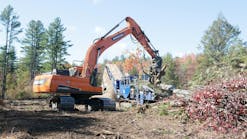Giorgio Carera, FAE USA CEO, points out that while job-site preparation is site specific, “a constant part of site prep is the removal of trees and other branches and foliage in order to have bare land to perform whatever other jobs are required.
“The land clearing is the first step to site prep. It is imperative that it is done well and professionally to obtain a perfect site for developing whatever project is intended to be accomplished.”
Giorgio Carera, FAE USA CEO, points out that while job-site preparation is site specific, “a constant part of site prep is the removal of trees and other branches and foliage in order to have bare land to perform whatever other jobs are required. “The land clearing is the first step to site prep. It is imperative that it is done well and professionally to obtain a perfect site for developing whatever project is intended to be accomplished.” [text_ad] Site preparation can entail the physical removal of foliage as well as a more high-tech endeavor that can involve mapping and telematics, says Carera. “It could be a basic clearing for a food plot, garden, or similar, or it could be a more technical systematic job using GPS coordinates that have to be exact such as power lines, roads, oil stations, lots for homes, and similar,” he adds. “The tractors and FAE-dedicated carriers can operate using the GPS and leave no error for the operator.” FAE USA supplies equipment for all aspects of job-site preparation, including PTO/HYD mulchers for the initial land clearing; PTO/HYD forestry tillers and multi-purpose machines for stump removal, and to incorporate loose branches and other material left after mulching into the ground; and PTO/HYD machines that can mix additives in the ground for a final clean, stable surface.- One FAE UML/SSL 175 forestry mulcher on a Supertrak SK120, which shreds up to 8-inch diameter trees.
- One FAE DML/SSL 150 forestry mulcher on a Kubota SVL 90-2 with FAE oil cooler, which shreds up to 6-inch diameter trees.
- One FAE SSL/ST 150 forestry tiller on NH TV 145, which grinds to 11 inches in depth and is used for soil stabilization and incorporating stumps, roots, and branches.
- One STC/SSL150 rock crusher on Supertrak SK120, which crushes rocks, concrete, and field stone, among other materials, up to 3 inches of depth.
- One RSL 150 on NH TV 145, which recycles black top, tar and chip, and gravel roads up to 11 inches of depth. Materials can be reused onsite. Polymers can be added with a water attachment to profile and compact the road.
Site preparation can entail the physical removal of foliage as well as a more high-tech endeavor that can involve mapping and telematics, says Carera.
“It could be a basic clearing for a food plot, garden, or similar, or it could be a more technical systematic job using GPS coordinates that have to be exact such as power lines, roads, oil stations, lots for homes, and similar,” he adds. “The tractors and FAE-dedicated carriers can operate using the GPS and leave no error for the operator.”
FAE USA supplies equipment for all aspects of job-site preparation, including PTO/HYD mulchers for the initial land clearing; PTO/HYD forestry tillers and multi-purpose machines for stump removal, and to incorporate loose branches and other material left after mulching into the ground; and PTO/HYD machines that can mix additives in the ground for a final clean, stable surface.
For erosion control material, “the mulch from the tree can be incorporated in the ground with FAE forestry tillers to create a base of more than just dirt and reduce the ground’s erosion drastically,” says Carera.
One company that uses FAE equipment is Carl W. Neutzel Services of White Hall, MD. The company is small and performs a lot of services, and as such, must use equipment to run lean, says its president, Carl Neutzel.
“Our biggest concern is we’re trying to be more efficient, safer, and more environmentally friendly with the use of equipment,” he says, adding the equipment is used to doing onsite job preparation where the organic matter stays onsite. “We also are concerned about run-off into the Chesapeake Bay.”
Carl W. Neutzel Services started off in the landscaping business in 1972, then progressed into doing work in grass seeding, mechanical, and chemical invasive species control, and wildlife habitat work on sites ranging from a half acre to 100 acres for the private and government sector.
Carl W. Neutzel Services does job-site preparation for building lots, wildlife habitat, seed plots, and other purposes.
Neutzel says the work is divided between aboveground and belowground tasks. Aboveground work entails grinding trees, brush, and invasive species. Belowground work encompasses grinding up stumps and roots and working the debris into the ground.
“A lot of the invasive species work is to get rid of anything that’s non-native because it becomes part of the whole cycle of native plants and animals and disrupts the whole cycle,” says Neutzel, adding many have come from other countries either by accident or intentionally.
“Some of it also is along the highways, growing in the ditches and causing problems with drainage and maintenance of power lines and lights,” he adds.
Neutzel uses FAE equipment for his company’s tasks. The company’s fleet includes:
- One FAE UML/SSL 175 forestry mulcher on a Supertrak SK120, which shreds up to 8-inch diameter trees.
- One FAE DML/SSL 150 forestry mulcher on a Kubota SVL 90-2 with FAE oil cooler, which shreds up to 6-inch diameter trees.
- One FAE SSL/ST 150 forestry tiller on NH TV 145, which grinds to 11 inches in depth and is used for soil stabilization and incorporating stumps, roots, and branches.
- One STC/SSL150 rock crusher on Supertrak SK120, which crushes rocks, concrete, and field stone, among other materials, up to 3 inches of depth.
- One RSL 150 on NH TV 145, which recycles black top, tar and chip, and gravel roads up to 11 inches of depth. Materials can be reused onsite. Polymers can be added with a water attachment to profile and compact the road.
Neutzel is cognizant that his company’s work is critical to the overall success of a project.
“You’ve got all of that material out of the way to begin with so they don’t have to deal with it later. They can see what they’re doing a little bit better,” he says. “We do some site line work for surveyors, clearing it up so they can get in and work. It makes their job easier because it’s gone when they’re getting ready to start.”
Most times, the crew of Carl W. Neutzel Services works the foliage back into the ground with a forestry tiller.
“That’s helping with the carbon footprint because we’re not using extra fuel to haul it away,” says Neutzel, adding that it cuts down on costs. “It’s not going to a landfill—it gets worked right back into the ground and it can add organic matter into the ground, too.”
The organic matter also acts as ideal erosion control and stormwater management.
“When we get finished, we grind it up and work it in. It’s all matted and knitted together with the roots and little pieces of branches and wood that we’ve ground up and you can drive over it with a car when you’re finished because it’s pretty smooth,” he says.
Neutzel points out that the use of equipment makes it easier for jobs to get done without the need for excess labor. And for those people working on the crew, the equipment creates a safer environment, he adds.
“One of the things that’s important with the equipment is we can do work safer in the cab than people out there doing it with chainsaws and brush cutters and putting it in a chipper,” he says. “With vines hanging from the trees, it’s a lot safer when the operators are in the safety of the cab.”
Neutzel is so impressed by the benefits he’s derived using the FAE equipment for job-site preparation that he did a demo project of an FAE rock crusher for a company building an earthen dam in Virginia.







